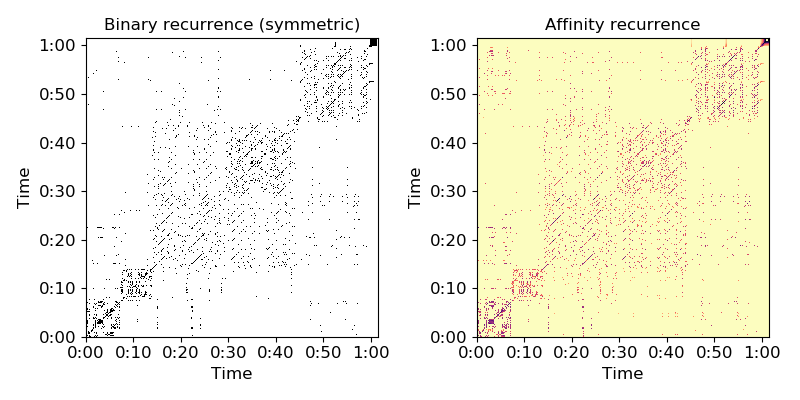librosa.segment.recurrence_matrix¶
-
librosa.segment.recurrence_matrix(data, k=None, width=1, metric=’euclidean’, sym=False, sparse=False, mode=’connectivity’, bandwidth=None, axis=-1)[source]¶ Compute a recurrence matrix from a data matrix.
rec[i, j] is non-zero if (data[:, i], data[:, j]) are k-nearest-neighbors and |i - j| >= width
Parameters: - data : np.ndarray
A feature matrix
- k : int > 0 [scalar] or None
the number of nearest-neighbors for each sample
Default: k = 2 * ceil(sqrt(t - 2 * width + 1)), or k = 2 if t <= 2 * width + 1
- width : int >= 1 [scalar]
only link neighbors (data[:, i], data[:, j]) if |i - j| >= width
- metric : str
Distance metric to use for nearest-neighbor calculation.
See
sklearn.neighbors.NearestNeighborsfor details.- sym : bool [scalar]
set sym=True to only link mutual nearest-neighbors
- sparse : bool [scalar]
if False, returns a dense type (ndarray) if True, returns a sparse type (scipy.sparse.csr_matrix)
- mode : str, {‘connectivity’, ‘distance’, ‘affinity’}
If ‘connectivity’, a binary connectivity matrix is produced.
If ‘distance’, then a non-zero entry contains the distance between points.
If ‘affinity’, then non-zero entries are mapped to exp( - distance(i, j) / bandwidth) where bandwidth is as specified below.
- bandwidth : None or float > 0
If using
mode='affinity', this can be used to set the bandwidth on the affinity kernel.If no value is provided, it is set automatically to the median distance between furthest nearest neighbors.
- axis : int
The axis along which to compute recurrence. By default, the last index (-1) is taken.
Returns: - rec : np.ndarray or scipy.sparse.csr_matrix, [shape=(t, t)]
Recurrence matrix
See also
sklearn.neighbors.NearestNeighbors,scipy.spatial.distance.cdist,librosa.feature.stack_memory,recurrence_to_lagNotes
This function caches at level 30.
Examples
Find nearest neighbors in MFCC space
>>> y, sr = librosa.load(librosa.util.example_audio_file()) >>> mfcc = librosa.feature.mfcc(y=y, sr=sr) >>> R = librosa.segment.recurrence_matrix(mfcc)
Or fix the number of nearest neighbors to 5
>>> R = librosa.segment.recurrence_matrix(mfcc, k=5)
Suppress neighbors within +- 7 samples
>>> R = librosa.segment.recurrence_matrix(mfcc, width=7)
Use cosine similarity instead of Euclidean distance
>>> R = librosa.segment.recurrence_matrix(mfcc, metric='cosine')
Require mutual nearest neighbors
>>> R = librosa.segment.recurrence_matrix(mfcc, sym=True)
Use an affinity matrix instead of binary connectivity
>>> R_aff = librosa.segment.recurrence_matrix(mfcc, mode='affinity')
Plot the feature and recurrence matrices
>>> import matplotlib.pyplot as plt >>> plt.figure(figsize=(8, 4)) >>> plt.subplot(1, 2, 1) >>> librosa.display.specshow(R, x_axis='time', y_axis='time') >>> plt.title('Binary recurrence (symmetric)') >>> plt.subplot(1, 2, 2) >>> librosa.display.specshow(R_aff, x_axis='time', y_axis='time', ... cmap='magma_r') >>> plt.title('Affinity recurrence') >>> plt.tight_layout()
